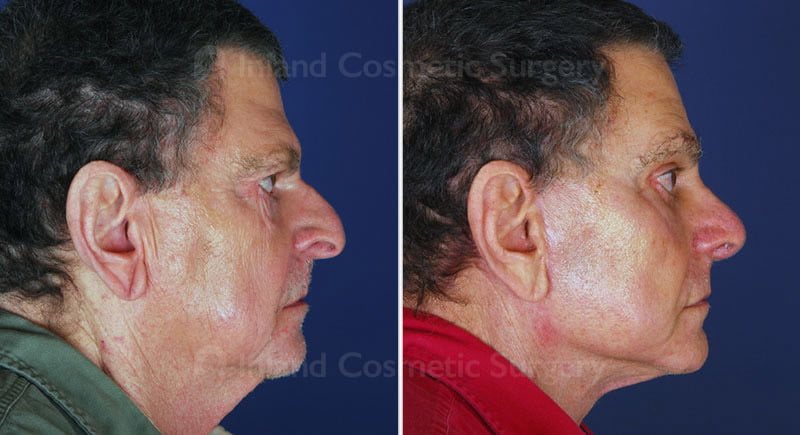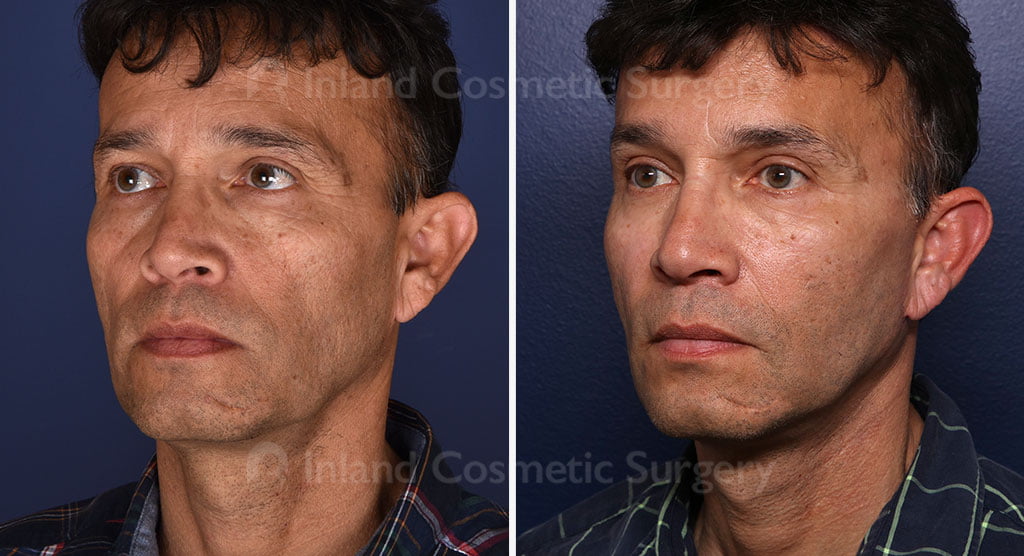Don’t let deep creases, jowls, & drooping skin rob you of your youthful good looks
We all get older, but the aging process isn’t always kind. While a well-placed wrinkle or two might give you a dashing George Clooney vibe, sometimes deep furrows and sagging skin on the face can hide your masculine features and leave you looking aged and tired. This happens as skin starts to lose its elasticity, fatty tissue is lost, and a lifetime of repetitive expressions start to make permanent wrinkles.
While this is a natural process, it doesn’t mean you can’t do anything about it. Our talented team of cosmetic surgeons have years of combined experience helping men in the Rancho Cucamonga, Victorville, and Eastvale areas feel great about the way they look, regardless of their age—and facelift surgery is one of the most effective ways to roll back the clock while retaining a sharp, masculine appearance that still looks like you.

Should I get a facelift?
With the availability of more and more minimally invasive options for addressing some of the most common signs of aging, it’s normal to hear our patients wonder if a facelift or another option is right for them. There’s no hard and fast rule about what age is best for a facelift, but we can help you decide when your concerns have outgrown the capabilities of non-surgical alternatives.
While the best way to decide if a facelift is the right choice for you is to consult with an experienced surgeon about your concerns, it’s likely you can benefit from the procedure if:
- You’ve noticed that the elasticity of your skin and muscle tone has decreased on your face and neck, leading to a droopy look
- The skin on your lower face is sagging and causing jowls that diminish the sharpness of your chin and jawline
- Furrows have deepened between the base of your nose and corners of your mouth
- Your face looks tired or angry all the time, even if you’re well-rested
When you come in for your consult with Dr. Jacob Haiavy or Dr. Emma Ryan at Inland Cosmetic Surgery, you’ll have the opportunity to explain your biggest concerns and what your ultimate goals are. With your input and their examination of your face, your surgeon will help you explore your options and determine if a facelift or other procedure is right for you.
What happens during a facelift?
A full, traditional facelift to address the mid-face and neck is performed under general anesthesia in our accredited surgery center in Rancho Cucamonga. Your cosmetic surgeon will strategically place small incisions in the natural contours of your face where they are least visible, typically inside the hairline at the temple, in front of the ear, or just behind the ear.
Through these incisions, skin will be lifted to reduce the depth of creases and minimize sagging, and the deeper structures of the face (muscles and fascia) will be tightened to eliminate jowling and give the face a more uplifted, youthful appearance. In cases where excess fat is contributing to fullness or jowling along the jawline, we may recommend using micro-liposuction techniques to enhance your results.
Many of our male patients are concerned about the effect of a facelift on their hairline, but our surgeons use a hair-sparing technique and are cautious of impacting an already receding hairline. By advancing tissue rather than excising it in areas where hair grows, we are able to keep your hairline in tact while also preventing an overly tight or unnatural final look—the majority of our tightening and lifting is done under the surface to make sure you still look like you when we’re finished.
- Key Benefits
- Glossary
- Reduction of Sagging Skin: A facelift tightens and lifts sagging skin, reducing jowls and giving a more youthful, firmer appearance to the lower face and neck.
- Reduction of Deep Wrinkles: A facelift can significantly reduce deep wrinkles and creases, especially around the nose and mouth (nasolabial folds), leading to a smoother complexion.
- Natural-Looking Results: Modern facelift techniques aim for natural-looking results, avoiding an over-stretched appearance and maintaining masculine facial characteristics.
- Long-Lasting Effects: Compared to non-surgical treatments, the results of a facelift are long-lasting, often enduring for many years.
- Anesthesia: Medications used to prevent pain during facelift surgery, which can be local or general.
- Blepharoplasty: Also known as eyelid surgery, a procedure that can be performed in conjunction with a facelift to rejuvenate the eyes by removing excess skin, muscle, and sometimes fat from the eyelids.
- Cervicoplasty: A surgical procedure focused on improving the appearance of the neck, often combined with a facelift.
- Deep Plane Facelift: A comprehensive type of facelift involving the repositioning of the entire facial musculature for more extensive results.
- Facelift (Rhytidectomy): A cosmetic surgery procedure to create a more youthful facial appearance by lifting and tightening sagging skin.
- Facial Rejuvenation: A broad term encompassing various cosmetic procedures, including facelifts, aimed at restoring a youthful appearance to the face.
- Furrows: Deep wrinkles or folds in the skin, often addressed during a facelift procedure.
- Incision: A surgical cut made during a facelift, typically around the hairline or ears, to facilitate skin lifting and tightening.
- Jowls: The sagging skin below the jawline, commonly targeted in facelifts to enhance the jaw’s contour.
- Mid-Face Lift: A facelift technique focusing on the mid-region of the face, including cheeks and lower eyelids.
- Mini-Facelift: A less invasive version of a traditional facelift, with a focus on minimal skin tightening and shorter recovery.
- Neck Lift: A procedure often done alongside a facelift to tighten the neck’s skin and muscles for improved appearance.
- Platysmaplasty: A surgical technique to tighten the platysma muscle in the neck, frequently included in a comprehensive facelift.
- Recovery Time: The healing period after a facelift, with specific care instructions for incisions and activity restrictions.
- Skin Elasticity: The skin’s ability to stretch and return to its original state, an important factor in determining the success of facelift procedures.
- SMAS (Superficial Musculoaponeurotic System): A facial tissue layer often manipulated during a facelift to achieve lasting aesthetic results.
- Submental Lipectomy: A procedure to remove excess fat under the chin, sometimes combined with a facelift for enhanced jawline definition.
The deep plane facelift technique
During a deep plane facelift, your surgeon will elevate and tighten the support structures beneath the skin to reduce the appearance of deep creases and minimize sagging. This tightening and elevating of the fatty tissue and underlying muscles helps uplift the face to a more youthful position while also eliminating jowling. In some cases, excess fat is also removed from the neck and jowls with micro-liposuction to enhance results.
Overall, this technique has proven to be superior to other lifting procedures, providing a stronger lift and a more balanced improvement. Because the lift relies on deeper structures and not just the skin and muscles, the results are far longer lasting.
At Inland Cosmetic Surgery, our cosmetic surgeons use a hair-sparing technique in which we advance tissue rather than excise it in hair-bearing areas. This keeps the hairline intact and helps to avoid an overly tight, unnatural appearance. This technique is key because the major pull, or tension, of the operation is on the deeper structures rather than on the skin.
Extended Subperiosteal Coronal Lift (ESCL)
If your areas of concern are concentrated in your mid-to-upper face, we may recommend an ESCL. This procedure is performed through an incision made across the top of your head inside your hairline and small incisions inside the mouth.
Your surgeon will then lift soft tissues and muscle upwards, effectively reversing gravitational changes of aging. This allows us to lift all of the structures of your face from forehead to jawline, including your brow, corners of your eyes, nasal tip, outer mouth, and jowls. Again, none of your hair will be removed, and hair bearing skin will remain intact.
We consider this technique to be a superior lifting option for certain patients, as it provides a stronger lift and more balanced improvement. Recovery is similar to a traditional facelift, though patients may experience a bit more initial swelling and some numbness in the scalp while healing. Results tend to be longer-lasting than a regular facelift.

Recovering after a facelift
While such dramatic improvements do require some downtime, many of our patients are surprised at how quickly they can start to resume their normal, day-to-day activities. For the first week, you’ll be wearing an elastic neck strap to help keep swelling down and protect your incisions—we’ve found this method to be less uncomfortable and restrictive than heavy bandaging.
The first day or two after surgery is going to be uncomfortable—we’ll prescribe you pain medication to help. You’ll need to take it easy and give your body time to heal, though we encourage patients to get up and move around as soon as the day of surgery. It’s normal to experience some swelling, bruising, and tightness for the first week or two, particularly around incisions.
Expect to be out of work for around 10 days and out of the gym for around 4-6 weeks. Your surgeon will give you specific milestones for returning to your favorite activities based on your personal rate of healing and the specifics of your procedure.
Additional procedures to boost your facelift results
While a facelift focuses on the mid-to-lower face and neck, it is often performed at the same time as upper face rejuvenation for more dramatic results. Patients may combine facelift with procedures such as blepharoplasty (eyelid surgery), brow lift, chin or cheek augmentation, or rhinoplasty.
In patients with very fine wrinkles of the skin surface, a facelift may be of limited benefit: other procedures, such as laser resurfacing or chemical peels, can address these skin texture issues. We have found that the combination of a facelift with laser resurfacing enhances the benefits of both procedures and results in a greater improvement of the overall facial appearance.
Frequently Asked Questions about Male Facelifts
When should I have a facelift?
A facelift can be performed at any time after signs of aging appear—there is no hard, fast rule about what age is best. You and your surgeon will decide together when the best time is for you to consider a facelift. Typically, it may be time to start thinking about your options once you start to see loss of skin elasticity and muscle tone, jowls beginning to form, and/or deep creases starting to set in on the mid-to-lower face.
How long does a facelift last?
Although the procedure does not stop the aging process, it certainly slows down the clock. The results of a facelift are typically long-lasting, though your genetics, degree of skin elasticity, and personal habits will play a role in how you continue to age.
Reach out to schedule your private consultationWe’d love to help you understand the options available to you and answer any questions you may have during a consult with one of our surgeons. Contact us today to get started!
Areas served:
Medically reviewed by Dr. Jacob Haiavy — Updated on Jan 30, 2025

